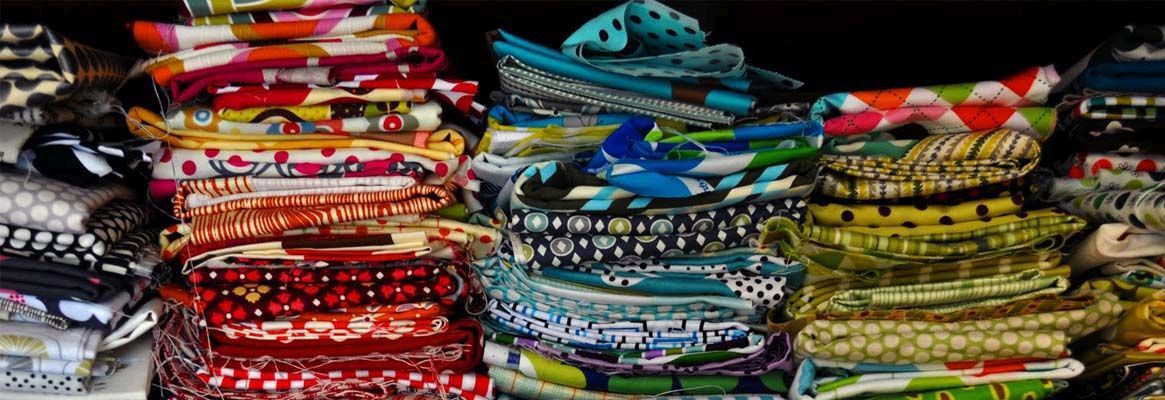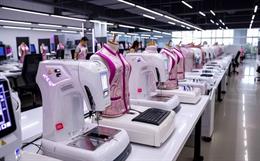In India, only 12 per cent oftechnical textiles are manufactured by nonwoven technology, compared to theglobal average of 24 per cent. The nonwoven market is expected to be around US$45 million by 2019, growing at a CAGR of 6.7 per cent. Subir Ghosh takes a lookat nonwovens as an opportunity for the Indian textiles industry.
Ever since the Ebola outbreakravaged through Africa last year, photographs of health workers in those whiteoutfits have dominated the foreign pages of newspapers. Most of these photographswould have evoked recollections of disaster movies. Not surprisingly.
Except, that everything here wasreal - right from the crisis itself to the health workers to the suits thatthey wore. A recognition for the latter came earlier this year. The US Agencyfor International Development (USAID) named first nominees in the 'FightingEbola: a Grand Challenge for Development' award. The innovators were identifiedfor the solutions they presented to increase the protection and comfort ofhealthcare workers battling Ebola.
Among these were Johns HopkinsUniversity's Centre for Bioengineering Innovation & Design (CBID) andJhpiego for a healthcare worker suit, redesigned for quicker and safer doffing/ removal with integrated cooling features utilising technology from JohnsHopkins University. Jhpiego is a non-profit Johns Hopkins affiliate thatfocuses on international health programmes.
In two months, innovators fromaround the world submitted over 1,500 ideas focused on helping frontline healthcare workers to provide better, more timely care, and to contain thedevastating virus. The first round of awards focused on improving the safetyand comfort of the personal protective equipment (PPE) worn by healthcareworkers and alleviating the heat stress it can cause in the hot, humid climatesof West Africa. Hundreds of healthcare workers died from Ebola last year,mostly because of insufficient gear. The new suit from the Johns Hopkins teampromises fewer chances to come in contact with the virus.
Some of the enhancements in thenew suit include a large clear visor in the hood, which is integrated into thesuit; air vents in the hood; a rear zipper to reduce infection risks whileremoving the garment; a cocoon-style doffing process that requires far fewersteps than existing garments; and a small battery-powered, dry air source tocool the user by blowing air into the hood. The cooling technology used in thegarment was originally developed for cooling patients in cardiac arrest by aJohns Hopkins cardiologist.
That was medical textiles at itstechnological best, and as contemporary and state-of-the-art as can be. Thefact that the term "medical textiles" did not dominate the mainstreamdiscourse or even in the mainstream media is a different matter altogether. Butthis fact itself is telling as well: the growing medical textiles industry inparticular and nonwoven textiles in general, does not quite find currency indiscussions and debates as yet. Yet, it's there, and growing by the day.
Eventually, the country's healthwill have a bearing on the health of this industry. And it could work the otherway too.
Key Indian manufacturers inmeditech segment:
- Baby diapers: Unimin India Ltd. and Fiberweb Pvt. Ltd.
- Sanitary napkins: Procter and Gamble, Johnson and Johnson and Kimberley Clark Lever
- Surgical disposables: Thea-Tex Healthcare Pvt. Ltd., Mediklin Healthcare Ltd., Sivshree Medittex India Pvt. Ltd.
- Surgical sutures: Johnson and Johnson, Centennial Surgical Suture Limited and Futura Surgicare Pvt. Ltd.
- Surgical dressing material: Johnson and Johnson India, Lavino Kapoor, Dr. Sabharwal Laboratories
- Artificial vascular grafts: TTK Healthcare in collaboration with Sri Chitra Tirunal
- Artificial tendon (mesh): TTK Healthcare in collaboration with Sri Chitra Tirunal
| Growth rates and estimated market size of technical textiles during 2012-17 (` crore) | ||||||||
| Sl. No | Technical Textile Sector and its products | Estimated market size during | Assumed growth rate during 12th Plan | 2012-13 | 2013-14 | 2014-15 | 2016-17 | 2018-19 |
| 1 | Clothtech: Shoe laces, interlinings, zips, narrow fabrics, taffeta fabric. | 9454 | 22 | 11345 | 13614 | 16337 | 19604 | 23525 |
| 2 | Packtech: Polyolefin woven sacks including FIBC, soft luggage products, food grade jute bags, jute sacks / hessian. | 23710 | 22 | 28927 | 35291 | 43055 | 52527 | 64083 |
| 3 | Sporttech: Shoe component, sports composites, sleeping bags, artificial turf, balloon & parachute fabrics. | 4297 | 17 | 5027 | 5882 | 6882 | 8052 | 9421 |
| 4 | Mobiltech: Seat belts, nylon tyre cord fabric, seat covers, carpets, helmets, headliners, insulation felts. | 4689 | 17 | 5486 | 6419 | 7510 | 8787 | 10281 |
Two products driving the hygiene nonwovens segment are diapers and sanitary napkins. Only 12 per cent of over 355 million women in the menstrual age group in India can afford branded sanitary napkins. Of the remaining 88 per cent, the better-offs use cloth. The rest have no other choice but to fall back on rags, straw, ash, mud and even husk. According to market research agency AC Nielsen, India's sanitary napkin market is largely untapped, and is growing at a rate of 24 per cent annually. Yet, it was left to a school dropout in Coimbatore city to manufacture a machine that would produce sanitary napkins at an affordable price for rural and poor women.
Inadequate menstrual protection compels adolescent girls - in the 12-18 age group - to miss around five days of school in a month, or 50 days in a year. Around 23 per cent of these girls drop out of school once they start menstruating. The AC Nielsen study had found that 31 per cent women report a drop in productivity levels when they menstruate, missing out on 2.2 days of work on an average. Sanitary napkins are not just about an untapped market, it is also a question of elementary human dignity. You cannot have a clean India by turning a blind eye to women's health. And you cannot expect the country to grow much either.
In 2013, the hygiene industry in India was estimated at ` 27 billion. What is shocking is that this is only $0.04 per capita, compared to Asia Pacific ($7.50), Western Europe ($34.90), and the US ($42.20). Sanitary protection and diapers constitute about 90 per cent of this market. The overall hygiene market is growing at 10 per cent, but remains hamstrung by income inequalities.
According to Euromonitor International, the retail hygiene industry in India was expected to double in value between 2014 and 2018, reaching ` 54 billion. Among factors that the nonwovens industry can look at is the country's birth rate, which was 22 per cent in 2013 and is projected to be 20 per cent in 2018. That would be 123 million children in the 0-4 age group every year. The female population in the 12-54 age group is expected to increase from 389 million in 2013 to 412 million by 2018. If each female spends US$ 2 on sanitary protection by 2018, the category could reach US$ 824 million. Even if 20 per cent of all consumers in this age group spend US$ 5 annually, the market could still reach a potential of US$ 412 million.
There are certain future trends that Euromonitor International talks about:
- For urban India, manufacturers need to focus on getting consumers to increase usage of hygiene products. By providing added functionality and features, they can justify a higher price positioning.
- Certain trends, such as increasing women in the workforce and nuclear families, will help increase the customer base for such products.
- Mothers returning to work post-maternity, which is usually three months, and children being cared for by extended family or care takers, is also a burgeoning trend expected to provide growth opportunities in the future.
- For rural India, the key is to increase awareness, product availability and affordability. Companies need to cooperate with the Indian government and work towards the main goal of improving standards of living.
- Manufacturers need to work on leveraging their established distribution networks to reach the masses in larger numbers in rural India. Distribution of free samples of diapers in hospitals and sanitary protection in secondary schools is an option.
|
6 |
Hometech: Fibrefill, jute carpet backing cloth, stuffed toys, blinds. |
7831 |
20 |
9397 |
11277 |
13532 |
16238 |
19486 |
|
7 |
Indutech: Conveyor belts, hoses, ropes, computer ribbons, battery separators, filtration products, decatising cloth, bolting cloth. |
4892 |
18 |
5772 |
6811 |
8037 |
9484 |
11191 |
|
8 |
Meditech: Sanitary napkins, incontinence diapers, baby diapers, surgical dressings, healthcare textiles, sutures, medical devices & implants. |
2298 |
20 |
2758 |
3310 |
3972 |
4766 |
5719 |
|
9 |
Protech: Fire retardant textiles, ballistic protective clothing etc. |
1890 |
23 |
2325 |
2860 |
3518 |
4327 |
5322 |
|
10 |
Geotech: Geotextiles, geomembrane, civil / geotechnical engineering. |
410 |
22 |
500 |
610 |
744 |
908 |
1108 |
|
11 |
Agrotech: Fishing nets & fishline, shade fabrics, woven and non woven covers for crops, mulch mat. |
751 |
20 |
901 |
1082 |
1298 |
1558 |
1869 |
|
12 |
*Oekotech: Environment control: municipal solid waste, industrial hazardous waste etc. |
135 |
22 |
164 |
201 |
245 |
299 |
364 |
|
|
Total |
63202 |
20 |
75925 |
91236 |
109659 |
131836 |
158540 |
* Oekotech size has already been considered as a part of geotech
The global nonwovens market: On a growth trajectory
The nonwoven fabrics sector, of which the medical textiles mentioned above is a part, is growing. The global nonwoven fabrics market is expected to grow at a compound annual growth rate (CAGR) of 6.97 per cent over the period 2014-2019, as per Research and Markets, on increased usage in the construction industry. Nonwoven textiles are widely used in the construction sector for applications such as house wraps and roofing materials, and as geotextiles.
Both infrastructural and construction spending are on the rise in the BRICS (i.e. Brazil, Russia, India, China and South Africa) nations and other developing countries owing to economic growth and growing populations. According to the report, the global demand for nonwoven fabrics is increasing in all these countries because of growing demand for medical disposable supplies from the medical sector. An increased demand for personal hygiene products owing to a rise in public awareness along with the growing population and increased incidence of medical conditions are propelling this demand for disposable medical supplies.
It is important to make the distinction between technical textiles and nonwovens here. Technical textiles are value-added textile products that provide added functionality and applications other than regular fibre-to-fashion supply chain products. Technical textiles include high performance fibres, yarns, woven, knitted, nonwoven, braided and composite structures.
On the other hand, a nonwoven, according to leading nonwovens association EDANA (or, European Disposables and Nonwovens Association), is a sheet of fibres, continuous filaments, or chopped yarns of any nature or origin, that have been formed into a web by any means, and bonded together by any means, with the exception of weaving or knitting. All nonwovens are technical textiles, but all technical textiles are not nonwovens.
This nonwovens market, however, is not a stable one. Volatile raw material prices is one of the major challenges digging the market. Nonwoven fabric feedstock is derived from crude oil, and any rise in global crude oil prices increases the cost of production and reduces the profit margins of manufacturers. Price, therefore, is a determining factor in the global nonwovens market.
According to a Grand View Research report, the staples PP (polypropylene) nonwoven fabric market by application (hygiene, industrial, medical, geotextiles, agriculture) is expected to reach US$ 9.02 billion by 2020. Growing baby diapers and adult incontinence products' demand will drive global staples PP nonwoven fabric market over the next six years.
That is not all. The overall global nonwoven fabrics market (including staples PP) is expected to reach US$ 42.1 billion by 2020, according to another study by Grand View Research. Growing production of baby diapers on account of increasing birth rate particularly in the Asia-Pacific region is expected to remain a key driving factor for the global nonwoven fabrics market.
Increasing expenditure on healthcare in the emerging markets of China and India have prompted the demand for protective medical apparel which is further expected to impact the market growth. Hygiene was the largest application segment and accounted for 37.5 per cent of the total market volume in 2013. Increasing geriatric population base, particularly in the US, Japan, and Western Europe will remain a key driver for this segment.
High birth rates in North African countries and Middle East (MENA region), coupled with increasing baby diaper usage in Southeast Asian countries are also expected to have a positive impact on the segment growth. The medical textiles segment is expected to witness the highest growth rate of 7.7 per cent from 2014 to 2020. The presence of sophisticated healthcare systems in developed economies like the US and Europe, coupled with increasing healthcare expenditure in South American and Asian countries, is expected to drive this segment.
So where does this leave India?
The Indian nonwovens industry: Weaving a growth path
India's nonwoven market is growing at a rate of 8-10 per cent. However, a growing GDP, increasing purchasing power parity (PPP) and initiatives towards economic development will boost this sector. Observers believe that the growth rate will be 12-15 per cent. At present, the annual production of nonwovens in India is around 190,000 tonnes. The per capita nonwoven fabric consumption is 155 gm, which will grow to 350 gm by 2015, and 600 gm by 2020.
Many MNCs like Ahlstrom, Terram, and Skaps have already set up shop in India; more are eyeing the Indian market. The Union government has created two special economic zones (SEZs) dedicated to technical textiles. There are nearly 50 nonwoven plants in the country.
With the increase in disposable income, the consumption of technical textiles on the whole is expected to increase. Based on past trends of growth and estimated end user segment growth, the Working Group on Technical Textiles for 12th Five Year Plan (FYP) had projected the market size to reach Rs 1,58,540 crore by 2016-17 at a year-on-year growth rate of 20 per cent during the 12th Five Year Plan. To tap the potential of technical textiles in India, the Union Ministry of Textiles had also implemented the Scheme for Growth and Development of Technical Textiles (SGDTT) from 2007-08 to 2010-11 during the 11th Five Year Plan.
Though India is the second largest textile economy after China, its contribution in the global technical textile industry is still comparatively insignificant. The maximum consumption of technical textiles is in the US, Western Europe and Japan, which together account for 65 per cent of the world consumption of technical textiles. China has also increased its consumption to over 15 per cent, whereas India accounts for only 8.6 per cent of the total global consumption. The potential of technical textiles in India still remains untapped.
The Working Group, which had based its assessment on findings from the earlier Plan period, had identified a number of opportunity areas: huge market potential of technical textiles in the country; huge potential for usage of technical textiles by institutional buyers like defence, security, health, roads and infrastructure; and the huge export potential of technical textiles.
At the same time, there were many areas of concern. Chief among them were dependence on import of technology and machinery for most high-end technical textiles products; available resources have not been augmented and updated with changing trends in application of technical textiles; non-availability of skilled human resources for technical textiles; lack of expert consultants for technical textiles for guiding entrepreneurs; non-availability of indigenous high performance speciality fibres for manufacture of technical textiles.
On the other hand, India's meditech segment (i.e. medical and hygiene products) is expected to grow at a rate of 20 per cent to US$ 1,039 million by 2016-17, as per estimates of the Working Group on Textiles and Jute Industry of the Union Ministry of Textiles.
Meditech products include textile material used in hygiene, health and personal care, as well as in surgical applications. These products include: wipes, baby and adult diapers, adult sanitary and incontinence products, as well as, medical and surgical products, such as operating gowns, operating drapes, sterilisation packs, dressings, sutures and orthopaedic pads.
At the highest value end of this segment are relatively tiny volumes of extremely sophisticated textiles for uses such as artificial ligaments, veins and arteries, skin replacement, hollow fibres for dialysis machines, etc. Meditech products are available in woven, knitted and nonwoven forms based on the area of application.
|
Cost Competitiveness of India vis-a-vis US, Europe and China |
||||
|
|
India |
US |
Europe |
China |
|
Overall Cost |
Least competitive |
More competitive than India by around 5.5-6% |
More competitive than India by around 5.5-6% |
More competitive than India by around 9% |
|
Labour cost (including the impact of productivity) |
Strong labour cost advantage primarily in labour intensive technical textiles products |
Labour cost disadvantage of around 8% as compared to India |
Labour cost disadvantage of around 7% as compared to India |
At par with India |
|
Technology |
Dependent on import of technology and machinery for most of the high end technical textiles products (including nonwovens) |
Strong |
Extremely strong |
Availability of low-cost machinery and technology (quality of products manufactured is not very good if cheaper technology is used) |
Source: Working Group on Technical Textiles, 12th Five Year Plan, Planning Commission.
|
Estimated segment-wise market size of technical textiles during XIth plan (` crore) |
|||
|
Segment |
2007-08 |
2011-12 |
Growth Rate %(CAGR) |
|
Clothtech |
6,908 |
9,454 |
8.16 |
|
Packtech |
1,302 |
23,710 |
12.83 |
|
Sporttech |
2,851 |
4,297 |
10.8 |
|
Mobiltech |
2,851 |
4,689 |
10.17 |
|
Buildtech |
2,157 |
2,980 |
8.42 |
|
Hometech |
5,025 |
7,831 |
11.73 |
|
Indutech |
3,206 |
4,892 |
11.14 |
|
Meditech |
1,669 |
2,298 |
8.33 |
|
Protech |
1,302 |
1,890 |
9.77 |
|
Geotech |
272 |
410 |
10.79 |
|
Agrotech |
553 |
751 |
7.96 |
|
Oekotech* |
68 |
135 |
18.66 |
* Oekotech size has already been considered as a part of geotech
Source: ICRA baseline survey report.
Key findings from Grand View Research study:
- Global staples PP nonwoven fabric demand was 1,949.2 kilotonnes in 2013 and is expected to reach 3,103.9 kilotonnes by 2020, growing at a CAGR of 6.9 per cent from 2014 to 2020.
- Global nonwoven fabrics demand was 8,687.2 kilotonnes in 2013 and is expected to reach 13,652.4 kilotonnes by 2020, growing at a CAGR of 6.7 per cent from 2014 to 2020.
- Asia-Pacific is the largest regional staples PP nonwoven fabric market and accounted for over 40 per cent of the total market volume in 2013. Growing baby diapers demand in India and China is expected to remain a key driving factor for the regional market.
- Global staples PP nonwoven fabric market is dominated by top multinational corporations. The market has witnessed frequent M&A activities in the recent past.
- Major companies adopt this strategy in order to reduce competition and gain market share. Some major companies operating in the global market include Fibertex, Kimberly-Clark, First Quality, Toray Industries, Mitsui, Fiberweb and Polymer Group Inc.
Nonwovens: Trends to watch out for
Nonwovens are described as the fabric of the future. EDANA, one of the largest and leading industry associations in the world, identifies three core areas in its Vision 2020 document: globalisation, sustainability and innovation. EDANA expects global economic power to shift eastward, with Europe, Japan and the US registering slower growth, and Asian economies growing faster. With low and middle income countries becoming the world's largest consumer markets, the demand in these countries for nonwoven products will rise. Agriculture and construction nonwovens will boom, and so will low-impact consumer and hygiene products.
The EDANA document remarks, "As a consequence (of fragmentation in attitudes on environmental stewardship and the willingness to accept new technologies), the increasingly global nonwovens market is likely to become polarised between two types of products. Many mass-produced ones targeting the global middle class will remain high-volume, with profit margins under pressure. In contrast, some increasingly tailored high-tech products for customers in high-income countries will be manufactured in relatively low volumes, usually with a higher value added. In both cases, low environmental impact will be the object of increased attention and will require innovative solutions."
Environment, in fact, keeps cropping up repeatedly in most EDANA documents. The association sees sustainability as the concern of the decade and emphasises that nonwovens contribute to making the world more sustainable: they help improve and protect not only people's lives but also the environment. The Vision 2020 document says, "Besides potentially increasing the release of greenhouse gases in the immediate future, exploding energy demand in Asia and increasing global consumption place a higher burden on already strained resources: oil, an important raw material for nonwovens, is becoming more difficult to find and refine. Increasing energy demands, in particular middle and low income countries, also heighten the environmental burden, for example in the form of air pollution in large Asian cities. These countries will have to place stringent environmental regulations on industry and transportation sectors, leading to an increased demand for air and water filtration systems."
So what's the way out? The EDANA document ties the threads together, and argues that innovation will be the key to addressing issues raised by stronger globalisation and a desire for sustainability. There are four technology groups and their convergence is where the scope lies: biotechnology, nanotechnology, materials technology, and information technology.
Customers and suppliers will be drawn into a collective process with companies. The document predicts, "Among innovation-related trends that are directly affecting the nonwovens industry is the growing global focus on health, driven by income growth, population ageing, new lifestyles (and their resulting disorders), health as a positive concept, and advances in artificially enhanced health and well-being. As a consequence, consumers will be increasingly sensitive to the chemical composition of nonwovens, but they will also focus on nonwovens for their ability to solve health problems, to improve health, and to help control healthcare-related costs."
A case for hygiene nonwovens
The Swachh Bharat Abhiyan (Or, Clean India Mission) campaign of the government of India covering 4,041 statutory towns across the country promises to be huge in scope and need. Though the emphasis is more on constructing toilets, water supply and sanitation projects, and elimination of manual scavenging, the hygiene angle is missing altogether. Herein lies a scope for industry to build on the initiative, by joining in on the awareness drive.







